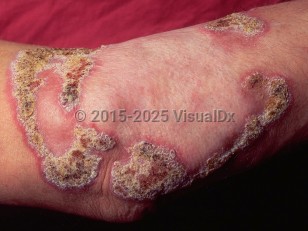Blastomycosis in Child
Alerts and Notices
Important News & Links
Synopsis

Blastomycosis, also known as Gilchrist disease and North American blastomycosis, is an infection caused by the dimorphic fungus Blastomyces dermatitidis, a soil organism endemic to much of North America. Other foci have been reported from Southern Africa, the Middle East, and India. The natural incidence is about 1-2 per 100 000 in endemic areas. Infection can involve almost any organ in the body, although the most commonly involved sites are the lungs, followed by the skin, bones, and genitourinary tract.
Infection can manifest acutely as a flu-like illness or pneumonia, or with a more indolent chronic pulmonary infection. The incubation period from exposure to the onset of pulmonary symptoms is about 3-6 weeks. Most patients present with cough, fever, sputum production, and chest pain with shortness of breath. One-third will have weight loss and night sweats, and 1 in 4 will have hemoptysis. Acute respiratory distress syndrome has been described in blastomycotic pneumonia, although overall it is not that common. Cases can clear spontaneously (about 50%) within 1-2 weeks or progress to a disseminated form that produces extrapulmonary manifestations in other organs, most commonly the skin and bones.
The disseminated form exhibits chronic cough, productive mucopurulent sputum, weight loss, and low-grade fever and mimics other granulomatous diseases.
Cutaneous manifestations can include crusted verrucous or ulcerated skin lesions. These often have irregular borders and range in color from gray to violet. Other lesions may be found in any organ system, especially the urinary tract. Rarely are lesions seen in the gastrointestinal tract. A chronic, generalized form of the disease has been reported.
Mortality rates in naturally acquired infections are about 5%. The mortality rate in immunocompromised patients is 29%, and in patients infected with HIV, it is 40%. Following the inhalation of fungal conidia, there is an average incubation period of 30-45 days, during which time the conidia convert to yeast forms in the lungs and then multiply and disseminate.
Blastomycosis is endemic to the midwestern, north-central, and southeastern parts of the United States. It is most common in areas bordering the Mississippi and Ohio River basins, the Canadian Great Lakes area, and the border of New York and Canada along the St. Lawrence River. Occupations at higher risk for contracting blastomycosis include gardeners, veterinarians, woodsmen, hunters, campers, farmers, and laboratory workers. Neither person-to-person nor animal-to-person transmission has been documented. No vaccine is available.
Note: Inhalation of airborne spores can be prevented by the use of a HEPA or N-95 filter mask.
Infection can manifest acutely as a flu-like illness or pneumonia, or with a more indolent chronic pulmonary infection. The incubation period from exposure to the onset of pulmonary symptoms is about 3-6 weeks. Most patients present with cough, fever, sputum production, and chest pain with shortness of breath. One-third will have weight loss and night sweats, and 1 in 4 will have hemoptysis. Acute respiratory distress syndrome has been described in blastomycotic pneumonia, although overall it is not that common. Cases can clear spontaneously (about 50%) within 1-2 weeks or progress to a disseminated form that produces extrapulmonary manifestations in other organs, most commonly the skin and bones.
The disseminated form exhibits chronic cough, productive mucopurulent sputum, weight loss, and low-grade fever and mimics other granulomatous diseases.
Cutaneous manifestations can include crusted verrucous or ulcerated skin lesions. These often have irregular borders and range in color from gray to violet. Other lesions may be found in any organ system, especially the urinary tract. Rarely are lesions seen in the gastrointestinal tract. A chronic, generalized form of the disease has been reported.
Mortality rates in naturally acquired infections are about 5%. The mortality rate in immunocompromised patients is 29%, and in patients infected with HIV, it is 40%. Following the inhalation of fungal conidia, there is an average incubation period of 30-45 days, during which time the conidia convert to yeast forms in the lungs and then multiply and disseminate.
Blastomycosis is endemic to the midwestern, north-central, and southeastern parts of the United States. It is most common in areas bordering the Mississippi and Ohio River basins, the Canadian Great Lakes area, and the border of New York and Canada along the St. Lawrence River. Occupations at higher risk for contracting blastomycosis include gardeners, veterinarians, woodsmen, hunters, campers, farmers, and laboratory workers. Neither person-to-person nor animal-to-person transmission has been documented. No vaccine is available.
Note: Inhalation of airborne spores can be prevented by the use of a HEPA or N-95 filter mask.
Codes
ICD10CM:
B40.9 – Blastomycosis, unspecified
SNOMEDCT:
69996000 – Blastomycosis
B40.9 – Blastomycosis, unspecified
SNOMEDCT:
69996000 – Blastomycosis
Look For
Subscription Required
Diagnostic Pearls
Subscription Required
Differential Diagnosis & Pitfalls

To perform a comparison, select diagnoses from the classic differential
Subscription Required
Best Tests
Subscription Required
Management Pearls
Subscription Required
Therapy
Subscription Required
References
Subscription Required
Last Reviewed:11/08/2017
Last Updated:08/22/2022
Last Updated:08/22/2022
Blastomycosis in Child

